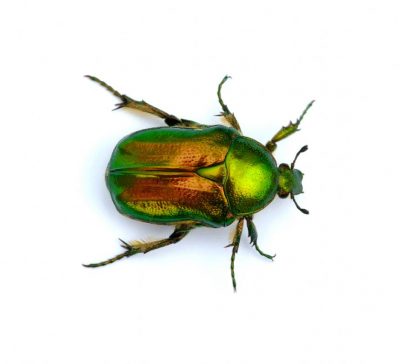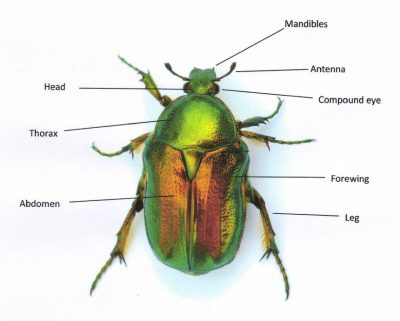Beetles


Beetles
Anatomy
Beetles are the largest group of living organisms worldwide. They have lived for over 270 million years. They have a head, thorax, abdomen and six legs. They also have a thick, shiny shell that protects them from predators and harsh elements. Adults have two sets of wings. The hard shell splits down the middle and opens out to form the beetle’s forewings. These forewings protect the inner set of wings, which are more delicate in comparison.
Beetles cannot see well, so they use smells, sounds and vibrations to communicate. Most beetles have developed methods to defend themselves, such as camouflage, toxic properties and fighting defences.
Weevils are a type of beetle. They have tiny mouthparts on the tip of a long beak.
Habitat
Beetles have been found on land and in freshwater. They can live on beaches and in deserts, forests, grasslands and mountain regions. They are able to adapt to harsh conditions. However, no beetles have been found in the polar ice caps or in saltwater.
Diet
Beetles mainly eat animal and plant debris. Some of the bigger species will eat small birds and mammals. However, many species of beetle are regarded as pests due to what they eat. Bark beetles and Mountain Pine beetles enjoy burrowing into trees to feed on the wood dust. They are responsible for killing millions of trees each year worldwide. The Khapra beetle eats grain and can devastate a farmer’s stored crops.
Beetles chew their food before swallowing.
Lifecycle
Female beetles lay hundreds of eggs. These eggs hatch into larvae that look like tiny maggots, called grubs. Beetles have a pupa state before turning into adults. Most beetles only live for a year.
Behaviour
Many beetles, such as cicadas, crickets and grasshoppers are very noisy. The cicadas make their sound by vibrating a drum-like organ inside their abdomens, called the tymbal. Grasshoppers rub their legs on their wings to make a sound. Male and female Bark beetles chirp. The Deathwatch beetle makes a loud knocking sound by banging their heads on the walls of wooden tunnels. Darkling beetles tap their abdomens on the ground. A June beetle will squeal if you pick it up.
Fireflies are beetles and they glow in the dark. They have a light organ on their abdomen. Tropical click beetles have a pair of oval light organs on the thorax and a third on the abdomen.
Different species
There are over 350, 000 species of beetles with more being discovered yearly.
Beetles vary in size. The Fringed Ant beetle is the smallest beetle. It is 0.25mm long. The Titan beetle from South America is the largest beetle. It grows 20cm long. The Goliath beetle is the heaviest beetle weighing 100 grams. Beetles are a wide variety of colours and can have stripes and spots.
Some of the most common beetles are:
• Dung beetle
The Dung beetle eats the droppings of other animals which helps break it down as fertilisers for the soil. However, they are very particular about which dung they will eat. Different varieties of Dung beetle will eat different animal’s dung. They also prefer their dung fresh. Dung beetles use the stars to help them navigate and on cloudy days will easily get lost. If walking across hot ground the Dung beetle will stand on their ball of dung to keep their feet cool. They are able to push fifty times their own body weight. The Scarab beetle is a variety of Dung beetle and was a popular sacred symbol in ancient Egypt.
• Stag beetle
They get their name from their jaws, which resemble a stag’s antlers. However, they do not use their jaws to catch prey as they eat sap. Male stag beetles use their antlers to wrestle other males during the mating season. They are able to fly but usually only fly during the mating season. Stag beetles are nocturnal. They have a long lifecycle lasting up to seven years from egg to adult. But the adults only live a few weeks and are unlikely to survive a winter.
• Click beetle
These grow about 13mm long and will eat a mixture of small insects and plant roots. There are over 7000 different varieties of click beetle. However, all of them will drop to the ground as a means of defence. If they land on their back they make a sharp clicking sound using their abdomen to flip themselves up the right way again.
